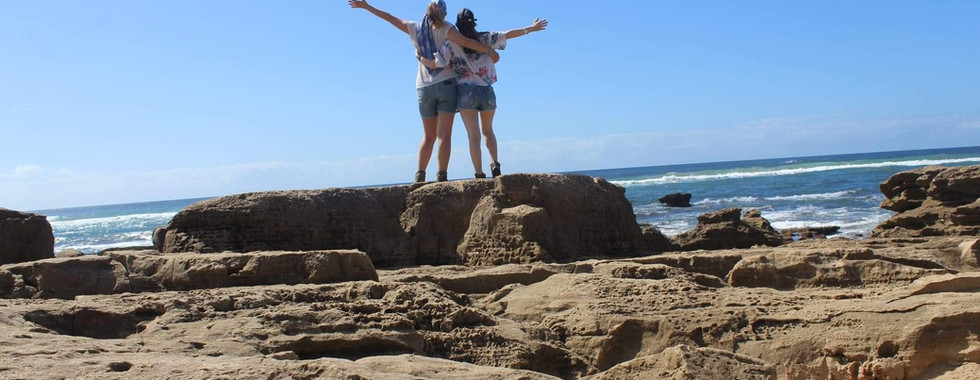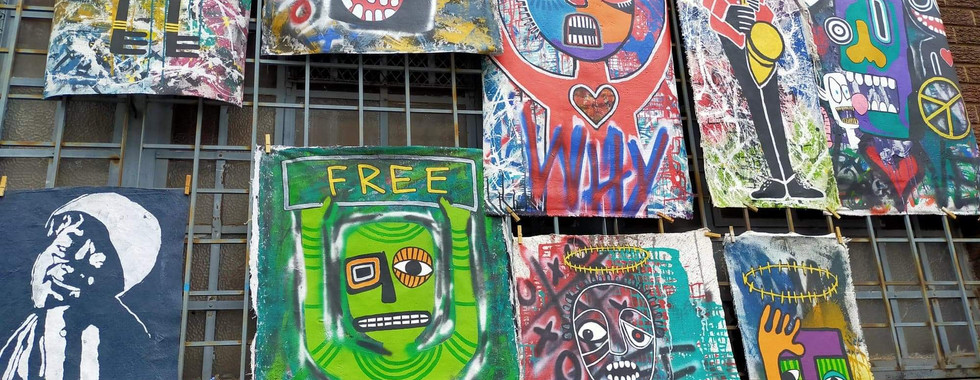Discovering South Africa through our research (and quick escape back to France!)
- Bakeng se Afrika

- Sep 17, 2020
- 5 min read
Iris and Lucile, two French MSc students in Biological Anthropology at the University of Bordeaux (France), spent a few weeks in South Africa thanks to exchange mobilities funded through the Bakeng se Afrika project. They tell us a bit about their respective research projects, their stay in SA and how – spoiler alert! – a global pandemic and a hard lockdown forced them to fly back home earlier than planned!

We arrived in South Africa in February 2020 for what was supposed to be a three-month mobility at the Forensic Anthropology Research Centre of the University of Pretoria. Even if we are both MSc students in Biological Anthropology, our research projects are very different!
Lucile’s research focused on the entheses (the surfaces where the muscles attach on a bone) present on the bones of the hand. She used a surface scanner to create precise 3D models of hand bones in order to isolate and virtually extract the entheses observed on these bones. She could then compute the size of each entheses’ surface area and analyse the interaction between those entheses, as well as the impact of different factors of variation, such as the individual’s sex, ancestry, age, activities, etc. It was found that sex and ancestry had an impact on those interactions, which might be linked to a difference in activities between females and males, as well as between ancestries. This means that, based on the interaction between hand bones entheses, we could identify some patterns of activity related to demographics, even if the sample was small. With the methods established, Lucile has paved the way for other studies to confirm the trends she found.
The research conducted by Iris focused on the relationships between the stress indicators of two hard tissues, using individuals from the Pretoria Bone Collection (housed at UP) and their associated micro-CT scans (hosted by Bakeng's server in the near future). The first stress marker investigated was facial Fluctuating Asymmetry (FA), which is a reflection of instability during early development as a result of genetic and/or environmental stresses affecting the individual. Facial FA was evaluated on crania micro-CT scans using geometric morphometrics. The second marker investigated was Linear Enamel Hypoplasia (LEH), which are horizontal grooves occurring on the surface of teeth as the result of physiological stressors during childhood, such as illness, injuries or malnutrition. Using traditional qualitative methods and digital callipers, Iris measured LEH defects on well-preserved teeth from individuals of the sample used for the facial FA analysis. Crown size, number and type of defects, as well as their location on the crown, were noted. During the first week at UP, dental impressions were also made using silicone (the green material in the pictures below). Once dry, after only a few minutes, the impressions could be removed from the teeth and filled in with a black resin material, in order to make high-resolution dental replicas. They are almost as precise as the original teeth and can be studied under the microscope using confocal profilometry. This 3D method allows a better assessment of the defects (depth, severity, type), while allowing researchers to continue working on the dental impressions, even when they are away from the research collections. Facial FA and LEH defects are both nonspecific indicators of stress and appear during early life, but the relationship between them is still poorly understood. Iris' objective was to assess the relationship between these indicators using 3D methods and associated data such as age, sex and ancestry of the individuals. Moreover, the South African sample allowed her to include the South African historical context into the research, and particularly see if Black South Africans and individuals born during the apartheid regime showed a higher level of physiological stress compared to the rest of sample.
Being together during this exchange made it more exciting and enriching! Iris’s co-supervisor, Dr Kate McGrath, also joined us during the first week of the mobility and it allowed us to spend some quality time with her and the team of the Anatomy Department. In fact, as soon as we arrived at UP, we were warmly welcomed by UP staff and by the anthropology section team! We met everybody during our visit and the kindness of the team made us feel really comfortable from the first day of our stay. The atmosphere was stimulating, and at the same time, peaceful to work in. Everyone was helpful with each other, and they made sure that we felt good. The campus was also pleasant, and it was nice to walk along and talk with people.
Aside from working, we also took some time to see the sights. We will definitely remember the kindness of Prof Erika L’Abbé and Marius Loots who drove us around and offered to take us to their next trip to the beautiful Kruger National Park. Thanks to them, we could “experiment” our first famous South African barbecue: the “Braai”. We saw some historical places in Pretoria, such as the Voortrekker Monument or the Union Buildings with Nelson Mandela’s famous statue. We also went to farmer markets, to the Moreleta Kloof Nature Reserve and saw the surroundings of Pretoria, which are so pretty. We also visited the Apartheid Museum in Johannesburg, with Erika and Kate, and it was truly an eye-opening experience about South African history. Unfortunately, we could not visit Joburg itself, as we wished to, but we spent another amazing day at the Maboneng Precinct, with the market on main, where you can meet very cool local creators and street artists!
Our best memory is most certainly the three days trip we had in Santa Lucia and its surroundings, on the northern Kwazulu-Natal coasts. Our Airbnb host happened to also work as a guide, and because we did not have a car, he drove us around and organised all our visits. You saved the trip Anthony! The landscapes were beautiful: Indian Ocean and its beaches and energetic waves, jungle, lake, and so on. We had an early morning horse riding on the beach, peaceful walks in town and in the area. We also had the chance to visit a traditional Zulu village where a healer told us that we were going to be rich and famous scientists (well... we hope she is right!). Our host took us on an improvised safari in the iSimangaliso Wetland National Park, where we could discover beautiful places and especially incredible beaches. Mother nature was quiet and shy on this particular day, but we still could see vervet monkeys, zebras, kudus, waterbucks, buffalos, warthogs, etc. On an evening, with a beautiful sunset, we went on a boat tour on the Lake Bhangazi where we could see hippos and even a crocodile! We took many pictures and videos to remember every detail of this amazing trip and this unforgettable experience.
We also planned to visit Cape Town, the Kruger Park and to explore paleontological and archaeological sites in Gauteng, but, in the middle of March, the Covid-19 pandemic arrived in South Africa. France started to close the borders, like many European countries and South Africa was starting to do the same… After many discussions with the French Embassy, with our supervisors in Bordeaux and also with our families, we decided to cut our stay short and to go back to France earlier than planned. We bought two of the last airplane tickets available for France and flew back to our country in the middle of the French lockdown. That was a bit stressful for us, but we were mostly sad because we wanted to stay longer in South Africa and spend more time with the people we met (we will also always have a special thought for the delicious Toni’s Pizza!). Fortunately, we had just enough time to collect data for our respective research projects.
We want to say thanks to all the people we met and especially for the Bakeng se Afrika team. We learned a lot and remember one thing: we will definitely come back!
Iris Pansin & Lucile Bousquié
















































Comments